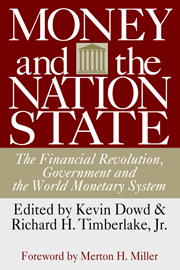For thousands of years, there has been a dominant international currency. Until August 15, 1971, when President Nixon closed the gold window and revoked the right of foreign governments to redeem their dollar assets for gold, all the dominant currencies had either been gold or silver coins, or paper notes or accounts that were redeemable for gold or silver.
Historically, these dominant currencies would come and go, with their demise typically being the result of wars and war finance. The United States dollar supplanted the British pound, which had been the world’s dominant currency in the 19th century, at the onset of the First World War.
Even though gold had been thrown overboard by Nixon, there was still a global monetary system in place: the “Bretton Woods system.” That system had been hammered out by a star-studded cast, including John Maynard Keynes, in Bretton Woods, New Hampshire during three short weeks in July 1944. Under the Bretton Woods regime, the values of the world’s major currencies were fixed, or at least were not allowed to vary too much.
Once gold was removed from the mix, though, the Bretton Woods system broke down and was abandoned in 1973. Since then, the world has been flying blind. Indeed, we have—in the words of Jacques de Larosière, the former managing director of the International Monetary Fund—a global monetary non-system.
So, what happened after the fateful events of 1971 and 1973? It was a bit like going over Niagara Falls in a barrel. Above the falls, waters are calm. Below, waters are turbulent. The transition is brutal. Indeed, the transition from a system of “fixed” exchange rates that were linked, however loosely, with gold to a non-system of floating exchange rates was brutal.
The value of a dollar plunged to an 850th of an ounce of gold in 1980 from a 35th of an ounce in 1970. The stock market tanked, with the Dow plunging 45% from its high in January 1973 until December 1974. The dollar also tanked against the mighty Swiss franc, losing 65.5% of its value between January 1971 and October 1978.
In short, the 1970s turned into an economic nightmare for the United States. Thanks to the decade of the 1970s, the word “stagflation” entered our lexicon. After the tumultuous transition, moreover, sailing hasn’t been that smooth. The frequency and severity of major international financial crises has picked up.
Remember the Mexican tequila crisis of the mid-1990s, the Asian Financial Crisis, and the Russian ruble rout, among others? Banking crises have visited us with more frequency and severity, too. In America alone, who can forget the savings and loan crisis of the 1980s or the Lehman Brothers fiasco of 2008?
Things haven’t been great for American consumers and savers either. A dollar from 1971, after five decades of inflation, would only be worth 15 cents today.
It’s time to replace our non-system with a new Bretton Woods. Bretton Woods was the result of a perfect storm: some big problems; a set of ideas that attracted a consensus; a group of prepared and capable participants; and a leader, namely the United States, that was prepared to lead.
Today, I don‘t see such a perfect storm on the horizon. Then again, a collapse of the rapidly expanding cryptocurrency ecosystem might just be enough to signal the coming of such a storm.










